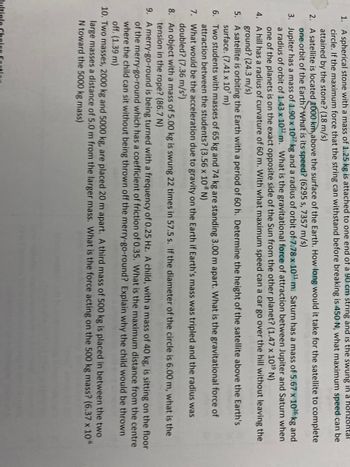
College Physics
11th Edition
ISBN: 9781305952300
Author: Raymond A. Serway, Chris Vuille
Publisher: Cengage Learning
expand_more
expand_more
format_list_bulleted
Concept explainers
Question
Please help me with question 2

Transcribed Image Text:1. A spherical stone with a mass of 1.25 kg is attached to one end of a 90 cm string and is the swung in a horizontal
circle. If the maximum force that the string can withstand before breaking is 450 N, what maximum speed can be
attained by the stone? (18 m/s)
2.
A satellite is located 1000 km above the surface of the Earth. How long would it take for the satellite to complete
one orbit of the Earth? What is its speed? (6295 s, 7357 m/s)
3. Jupiter has a mass of 1.90 x 1027 kg and a radius of orbit of 7.78 x 10¹¹ m. Saturn has a mass of 5.67 x 1026 kg and
a radius of orbit of 1.43 x 10¹2 m. What is the gravitational force of attraction between Jupiter and Saturn when
one of the planets is on the exact opposite side of the Sun from the other planet? (1.47 x 10¹9 N)
4.
A hill has a radius of curvature of 60 m. With what maximum speed can a car go over the hill without leaving the
ground? (24.3 m/s)
5.
A satellite is orbiting the Earth with a period of 60 h. Determine the height of the satellite above the Earth's
surface. (7.41 x 107 m)
6.
Two students with masses of 65 kg and 74 kg are standing 3.00 m apart. What is the gravitational force of
attraction between the students? (3.56 x 108 N)
7.
What would be the acceleration due to gravity on the Earth if Earth's mass was tripled and the radius was
doubled? (7.36 m/s²)
8.
An object with a mass of 5.00 kg is swung 22 times in 57.5 s. If the diameter of the circle is 6.00 m, what is the
tension in the rope? (86.7 N)
9.
A merry-go-round is being turned with a frequency of 0.25 Hz. A child, with a mass of 40 kg, is sitting on the floor
of the merry-go-round which has a coefficient of friction of 0.35. What is the maximum distance from the centre
where the child can sit without being thrown off the merry-go-round? Explain why the child would be thrown
off. (1.39 m)
10. Two masses, 2000 kg and 5000 kg, are placed 20 m apart. A third mass of 500 kg is placed in between the two
large masses a distance of 5.0 m from the larger mass. What is the force acting on the 500 kg mass? (6.37 x 10°
N toward the 5000 kg mass)
Expert Solution
This question has been solved!
Explore an expertly crafted, step-by-step solution for a thorough understanding of key concepts.
Step by stepSolved in 3 steps with 3 images

Knowledge Booster
Learn more about
Need a deep-dive on the concept behind this application? Look no further. Learn more about this topic, physics and related others by exploring similar questions and additional content below.Similar questions
arrow_back_ios
arrow_forward_ios
Recommended textbooks for you
 College PhysicsPhysicsISBN:9781305952300Author:Raymond A. Serway, Chris VuillePublisher:Cengage Learning
College PhysicsPhysicsISBN:9781305952300Author:Raymond A. Serway, Chris VuillePublisher:Cengage Learning University Physics (14th Edition)PhysicsISBN:9780133969290Author:Hugh D. Young, Roger A. FreedmanPublisher:PEARSON
University Physics (14th Edition)PhysicsISBN:9780133969290Author:Hugh D. Young, Roger A. FreedmanPublisher:PEARSON Introduction To Quantum MechanicsPhysicsISBN:9781107189638Author:Griffiths, David J., Schroeter, Darrell F.Publisher:Cambridge University Press
Introduction To Quantum MechanicsPhysicsISBN:9781107189638Author:Griffiths, David J., Schroeter, Darrell F.Publisher:Cambridge University Press Physics for Scientists and EngineersPhysicsISBN:9781337553278Author:Raymond A. Serway, John W. JewettPublisher:Cengage Learning
Physics for Scientists and EngineersPhysicsISBN:9781337553278Author:Raymond A. Serway, John W. JewettPublisher:Cengage Learning Lecture- Tutorials for Introductory AstronomyPhysicsISBN:9780321820464Author:Edward E. Prather, Tim P. Slater, Jeff P. Adams, Gina BrissendenPublisher:Addison-Wesley
Lecture- Tutorials for Introductory AstronomyPhysicsISBN:9780321820464Author:Edward E. Prather, Tim P. Slater, Jeff P. Adams, Gina BrissendenPublisher:Addison-Wesley College Physics: A Strategic Approach (4th Editio...PhysicsISBN:9780134609034Author:Randall D. Knight (Professor Emeritus), Brian Jones, Stuart FieldPublisher:PEARSON
College Physics: A Strategic Approach (4th Editio...PhysicsISBN:9780134609034Author:Randall D. Knight (Professor Emeritus), Brian Jones, Stuart FieldPublisher:PEARSON

College Physics
Physics
ISBN:9781305952300
Author:Raymond A. Serway, Chris Vuille
Publisher:Cengage Learning

University Physics (14th Edition)
Physics
ISBN:9780133969290
Author:Hugh D. Young, Roger A. Freedman
Publisher:PEARSON

Introduction To Quantum Mechanics
Physics
ISBN:9781107189638
Author:Griffiths, David J., Schroeter, Darrell F.
Publisher:Cambridge University Press

Physics for Scientists and Engineers
Physics
ISBN:9781337553278
Author:Raymond A. Serway, John W. Jewett
Publisher:Cengage Learning

Lecture- Tutorials for Introductory Astronomy
Physics
ISBN:9780321820464
Author:Edward E. Prather, Tim P. Slater, Jeff P. Adams, Gina Brissenden
Publisher:Addison-Wesley

College Physics: A Strategic Approach (4th Editio...
Physics
ISBN:9780134609034
Author:Randall D. Knight (Professor Emeritus), Brian Jones, Stuart Field
Publisher:PEARSON